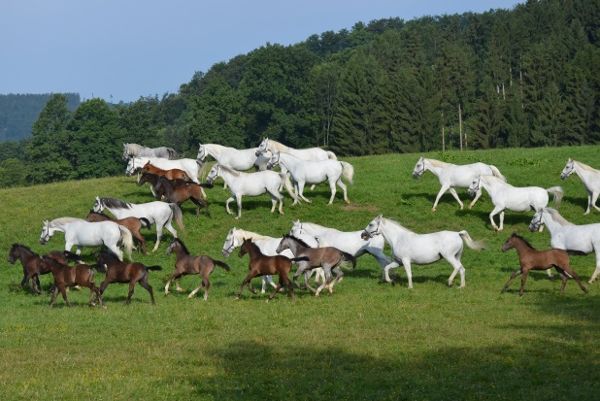Horse keeping in Austria

Every five years, most recently from 4 to 7 June 2015, the Haflinger World Show, which is billed the world's biggest horse breeding show, is held in Ebbs, in the Austrian Federal Province of Tyrol, featuring over 700 Haflinger horses from 18 different nations.
Roughly half of the animals were presented by members of the Tyrolean Haflinger Horse Breeders Association while the remaining 350 Haflingers originated from member organisations of the World Haflinger Breeding and Sports Federation.
The Tyrolean Haflinger Horse Breeding Association has been holding international shows on a regular basis since 1947 and, since 1990, all five World Shows have been held on the premises of the Fohlenhof in Ebbs.
Horse farming is a significant economic factor in Austrian agriculture. With an estimated horse population of 120,000 head (source: Pferd Austria, 2014) and a macroeconomic impact valued at 2.1 billion Euros, horses secure up to 23,000 jobs (source: Pferd Austria: IWI, 2011).
Approximately 90,000 horses, or 75 %, of all horses kept in Austria, are kept at agricultural holdings.
The management of the horses requires some 100,000 ha of land as well as around 160,000 tonnes of feed grains and 180,000 tonnes of hay (source: Frickh, 2012, document for the 1st Austrian Horse Symposium).
Out of the total of 25,000 Austrian horse farms approx. 12,500 are breeding farms. They keep around 17,000 broodmares and 1,800 breeding stallions.
24 associations are members to the Federation of Austrian Horse Breeders (ZAP).
Horse farms generate added value through breeding and the livery of horses, on the one hand, and through the production of special fodder for the equine industry, on the other. With domestic consumption totalling 191 tonnes of horse meat (source: Statistics Austria, 2013), horse slaughter is of rather minor importance in Austria.
In 2004, the Federal Ministry of Agriculture, Forestry, Regions and Water Management set up the PferdAustria platform.
Since that time numerous events revolving around the horse have been organised and four key studies have been conducted: "Wirtschaftsfaktor Pferd” (The Horse as an Economic Factor), "Sozialfaktor Pferd” (The Horse as a Social Factor), "Tourismus- und Freizeitfaktor Pferd” (The Horse as a Tourism and Recreational Factor) and "Pferd und Gesundheit - Prävention und Therapie” (Horse and Health – Prevention and Therapy).
In addition to the major breeds - Haflinger, Noriker, Austrian Warmblood, and the world-famous Lipizzaner - 47 more horse breeds are kept by 30 recognised horse-breeding associations.
The Lipizzaner, which is considered one of Europe's oldest domesticated horse breed, is frugal, enduring, docile, motivated and exceedingly good-natured. For the Spanish Riding School in Vienna, Lipizzaner stallions are bred at the Piber Federal Stud.
The Austrian Warmblood is described as noble, long-lined, correct and powerful horse with good movement and jumping abilities suited for any type of recreational riding. Despite the relatively small breeding base of 2,500 mares and 80 stallions, Austrian Warmbloods have achieved considerable success in national and international equestrian events.
The Noriker is a moderately heavy mountain draught horse that is sure-footed and has a good sense of balance. Whereas Noriker horses originally used to be workhorses and farm horses, they are now used for recreational purposes in equitation and carriage driving (horse-drawn carriages, for instance) and represent an integral part of the farming tradition.
Haflingers are chestnut-coloured impressive, modern horses with riding horse points and long white manes and tails. Their height at the withers varies between 140 and 150 cm. Originally, Haflingers were used as packhorses by mountain farmers and as cart and work horses by the military and in the agricultural sector.
The foaling mares are the centre of attention at the Lipizzaner stud farm in Piber: They provide progeny for the Spanish Riding School in Vienna.
The Lipizzaner breed, which represents one of Europe's oldest domesticated horse breeds, dates back to 1580. Four hundred years of Lipizzaner breeding are what inspires the thriving tradition at the Piber Lipizzaner stud farm. This is where horses are bred for the special dressage manoeuvres for which they have become famous around the world, especially thanks to the Spanish Riding School.
The young animals aged between one and three spend their summer months on mountain pastures at 1,500 metres above sea level. The time spent on mountain pastures is an important stage in the rearing of the Lipizzaner horses. By galloping and trotting across the occasionally steep and stony slopes of the pastures, the horses gain the necessary surefootedness, endurance and hardiness.
The specific requirements for the Spanish Horse Riding School – Federal Stud of Piber are set forth in the Austrian Spanish Riding School Act.